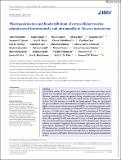Pharmacokinetics and biodistribution of extracellular vesicles administered intravenously and intranasally to Macaca nemestrina
Author(s)
Driedonks, Tom; Jiang, Linglei; Carlson, Bess; Han, Zheng; Liu, Guanshu; Queen, Suzanne E; Shirk, Erin N; Gololobova, Olesia; Liao, Zhaohao; Nyberg, Lyle H; Lima, Gabriela; Paniushkina, Liliia; Garcia-Contreras, Marta; Schonvisky, Kayla; Castell, Natalie; Stover, Mitchel; Guerrero-Martin, Selena; Richardson, Riley; Smith, Barbara; Machairaki, Vasiliki; Lai, Charles P; Izzi, Jessica M; Hutchinson, Eric K; Pate, Kelly AM; Witwer, Kenneth W; ... Show more Show less
DownloadPublished version (2.121Mb)
Publisher with Creative Commons License
Publisher with Creative Commons License
Creative Commons Attribution
Terms of use
Metadata
Show full item recordAbstract
Extracellular vesicles (EVs) have potential in disease treatment since they can be loaded with therapeutic molecules and engineered for retention by specific tissues. However, questions remain on optimal dosing, administration, and pharmacokinetics. Previous studies have addressed biodistribution and pharmacokinetics in rodents, but little evidence is available for larger animals. Here, we investigated the pharmacokinetics and biodistribution of Expi293F-derived EVs labelled with a highly sensitive nanoluciferase reporter (palmGRET) in a non-human primate model (Macaca nemestrina), comparing intravenous (IV) and intranasal (IN) administration over a 125-fold dose range. We report that EVs administered IV had longer circulation times in plasma than previously reported in mice and were detectable in cerebrospinal fluid (CSF) after 30-60 minutes. EV association with PBMCs, especially B-cells, was observed as early as one minute post-administration. EVs were detected in liver and spleen within one hour of IV administration. However, IN delivery was minimal, suggesting that pretreatment approaches may be needed in large animals. Furthermore, EV circulation times strongly decreased after repeated IV administration, possibly due to immune responses and with clear implications for xenogeneic EV-based therapeutics. We hope that our findings from this baseline study in macaques will help to inform future research and therapeutic development of EVs.
Date issued
2022Department
Massachusetts Institute of Technology. Department of Biological EngineeringJournal
Journal of Extracellular Biology
Publisher
Wiley
Citation
Driedonks, Tom, Jiang, Linglei, Carlson, Bess, Han, Zheng, Liu, Guanshu et al. 2022. "Pharmacokinetics and biodistribution of extracellular vesicles administered intravenously and intranasally to Macaca nemestrina." Journal of Extracellular Biology, 1 (10).
Version: Final published version